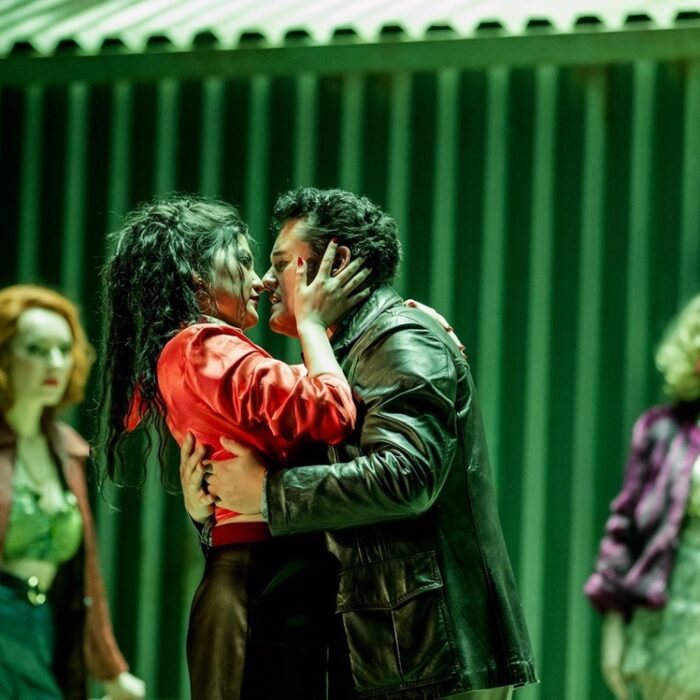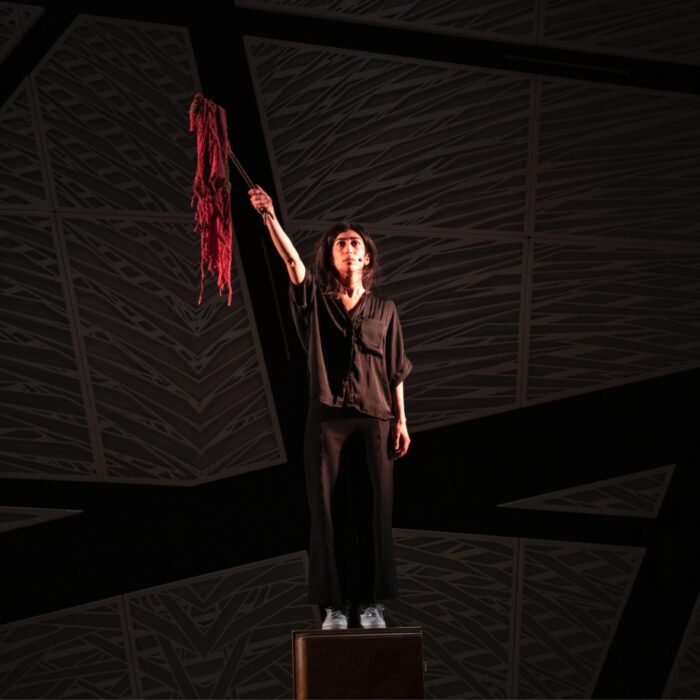
San Francisco Opera Virtual Review 2021 : Siegfried
Daniel Brenna, Greer Grimsley, Irene Theorin Dominate Fantastic Third Installment in Zambello’s Ring
By Lois SilversteinIn the 2018 San Francisco version of Francisca Zambello’s “Siegfried,” we get a touching side of the evolving picture Wagner depicts throughout The Ring cycle.
Here is the hero-to-be, Siegfried, son of the coupling of Siegmund and Sieglinde, deep in his forest home, with his parental surrogate, Mime. The encounter we witness at the start is full of baiting and irritation, brief attempts to resolve pique, and insistent demands of each to fulfill his own desire, Siegfried to find out who his parents were and what happened to them, and Mime, to inveigle Siegfried to get him the Ring and gain the power to rule the world.
After their characters are established in Scene one, the three acts unfold following the quest of each character and the ensuing contretemps – encounter with Alberich, the Machine Monster, the Forest Bird, the Wanderer, and, finally, Brunnhilde. It is a rich tapestry, filled with thrilling music and contrasting moods, and challenging psychological moments.
The highlight of Act one is Siegfried’s Forge-Song, the heaving of the hammer and the “hey te ho” of his vocal response, the swing of first one, then the other, creating an in tandem motion of the sun and the moon, the dark and the light, the love and the hate, of human beings in their world. Siegfried pieces the shards of his father’s sword Noting, together. The sword splits the Anvil when he succeeds at this. Each of the pairs, Mime and Siegfried, Alberich and Wotan, the Forest Bird and Siegfried, duet until all is resolved into the “Liebesbung”,Song of Love in Brünnhilde’s union with Siegfried. And what a highlight it is.
Star Tenors
American Heldentenor Daniel Brenna engaged us with extraordinary energy, liveliness, and vocal technique. Here was Siegfried sparkling, compelling, vigorous. Try to get that out of our heads? Unlikely. Try to dislike him ultimately, boor, bully, wild child? We can’t. He is too candid. Too honest. Too direct. Even his critique of Mime fits the style.
Yes, in human terms Siegfried is ungrateful for what Mime has given him. Tenor David Cangelosi’s Mime tells him plenty about that, and in full throttle. But acknowledge it as he does, Brenna’s Siegfried is not willing to substitute his dislike of his surrogate Father and Mother for contrived “ human”, i.e., social views. He is less than grateful for Mime’s rescue of him when Sieglinde bore him in the forest and dies; he dislikes him and is unwilling to say otherwise. He even brings with him a lively bear, a better companion, he says, than Mime. So, Siegfried mocks Mime and challenges his skill at reforging Notung, the sword of his father’s. He dares. He’s a fool, right? A blunt, open man, who is not afraid of doing what he wants and is proud of that.
Theatrically, it is refreshing, especially with the Forest Bird, Fafner, and eventually Brünnhilde. In fact, the contrast between conventional human values and what Siegfried expresses highlights Wagner’s aim to pit these against another set, part natural and unbridled and universal. This is no light matter. When Brünnhilde wakes and she discovers this, she exhibits uncertainty and doubt. Who can blame her? Asleep for 20 years and formerly a warrior-goddess, now she is on the human playing field. How should and can she act?
Exceptional Skill
Iréne Theorin, a well-known Swedish dramatic soprano, took us through the process with exceptional skill while bringing plenty of intensity, passion, dramatic flair, and beauty to the role At some moments her voice grew a bit shrill, but mostly, she sang with lustrous beauty and exceptional ardor. Her awakening on her rock was performed with moving detail, realistic and poignant. Her extraordinary smile alone gratified. She greeted Brenna’s Siegfried with delight and excited surprise. She loves him, she says, but he must stand back. She will not allow him to rule her with his passion either. He is smitten, but he is confused by this.
What Wagner is after here is to show us the perfect marriage of student and teacher. No master/slave portrayal, as many modern love portrays are. The would-be lovers have to explore how to be with each other but it is Brünnhilde who directs the show. Theorin’s vocal range coupled well with this dramatic power. Big, bold, and beautiful she is an ample beloved to Siegfried and the intricate and beautiful music leads us to consider love in the human realm other than what conventional human love may express. A new standard of conduct is afoot. While we may want to express our passion directly for what we feel as we have been conditioned to do, we are not simply free to do so.
As the opera unfolds, we see “anything goes” is not the point. The point is to suspend ourselves in the midst of strong feelings yet find ways to behave that fit who we are. Compare Fricka and Wotan, for example. While Fricka may be the Guardian of Marriage, it is not those laws that pertain to the ones Wagner details in the opera. Each character must sort it out for him or herself, and together. Daniel Brenna portrayed an affecting hero who must learn to love without rapacity while still ardent, who yearns but without greed or lust, and he learns this while he leans into Brünnhilde’s breast. It is a moving lesson.
So too with the Machine-Monster that Fafner, Raymond Aceto, has become. That is, until Siegfried kills him, cutting to the quick (the wire innards that make the machine run). But then, contrary to other human views, he feels sympathy and sadness for Fafner. It is one of the early connections that Siegfried makes, in fact, once he has dispensed with the need to make nice with Mime. for example, when he hands Mime a drink of his Pepsi Cola, while later repudiating Mime’s demand for human gratitude – this too is new.

(Credit: Cory Weaver)
Brenna’s Siegfried moved nimbly and actively up and down the stage, in and around the forest, over and under the rocks/caverns, all the time never failing to show us the same in his tenor sound. His voice carried the whole development without break, not only full of poignancy and almost sweet naivete, but amazing stamina. With the Forest Bird when he clownishly plays off-key music against the exquisite coloratura lyricism of Stacey Tappan, we have a rare moment of lightness and near-humor. The welcome relief of the first female voice when the Forest Bird arrives to aid Siegfried and Tappan sang with beauty and virtuosity; further, the two tossing Siegfried’s lovely turquoise scarf, a trace of Sieglinde, his mother, is also a charming and touching bit of staging. Then too with Brünnhilde. While strong and abundant, it carries the message of his newness, and it does not lack vulnerability. How he manages to convey ardor without lust is exceptional.
David Cangelosi’s Mime was practiced and smooth; so smooth sometimes, feeling falters and we are given art alone. He somersaults, he cartwheels, he whines and pouts, he grabs and contrives so that even though we “feel” for his plight – the underappreciated “parent”, we only think we do. His voice conveyed but disappointed with regard to conviction. Baritone Falk Struckmann played Alberich, Mime’s brother. He came through with more expression, complete with his homelessness apparel, goggles, and shopping cart. He conveyed the confusion and hesitation of someone who has a goal but does not stay steady on getting it as soon as an obstacle appears.
Bass-Baritone Greer Grimsley’s Wotan made a difference here, steadying and persuading. He entered as Wanderer and convinced us with commanding and demanding authority. His voice was sonorous and full, deep and determining. We welcomed him when he appeared, knowing he would pull fraying ends together, which he did, first with Mime correctly answering questions put to him by Mime, using the motifs of Giants, Spear, Valhalla, and, in turn, puts questions to Mime. Another contest in which Mime comes out the worse.
With Erda, Wotan’s request echoes his earlier dark, demanding self, only alluded to in this opera. Contralto Ronnita Miller’s Erda brought the strength of the earth in her voice, in trying to get the upper hand, remarkable in its depth and richness in its reach. She certainly succeeded in reaching Wotan, even though he succeeds in getting his way, once again.
Finally, he fights Siegfried, who demolishes Wotan’s Spear, and is able, then, to seek Brünnhilde.
Tying it All Together
Sir Donald Runnicles brought the “story” alive through every beat of the orchestra. “Siegfried” has been considered by some critics, one of the “lighter” operas of the Ring, but the music is nonetheless glorious. From the top of the sound range to the bottom, flute to bass, we bask in its beauty. Nine horns, two harps, although Wagner originally wanted several more, an abundance of strings, and more, we venture into a new landscape. Is the sound new? What with “Die Meistersinger” and “Tristan und Isolde” having been composed between the first Ring operas and the last, most likely so. More leitmotifs are woven together, more of the patterning of the whole is audible. Runnicles aptly detailed these and according to some orchestra members, succeeds in setting the whole narrative straight through to the end of “Die Götterdämmerung” from the opening notes of “Das Rheingold.” Some have even said they can follow the Ring without text or song and still know what is going on with ease. This could be the case here. The orchestra was alive and full of story; we never had to follow only the words.
Technical marvels delight us throughout, however, searching and expressive the story. Hissing steam, fire, under-lit floors, sparks from the forge, projections of forest and cloud abound, the original versions of these by Jan Hartley and remounted by S.Katy Tucker, make for a dazzling display, at once highlighting the theme of technology vs. nature in Zambello’s American Ring, but also just in itself. It reminds us how wondrous our first circus was – full of marvels we do not even dare to understand. Too much of a miracle. The imaginative lighting accents it all.
One more thing: when Brünnhilde begins to see herself in new ways, without weaponry, for example, without godlike powers, it is as if through Siegfried’s eyes. This catapults her to evolve in the direction Wagner aims – the humanity she will embrace in “Die Götterdämerung.” And we cannot wait.


